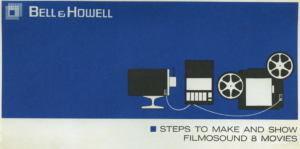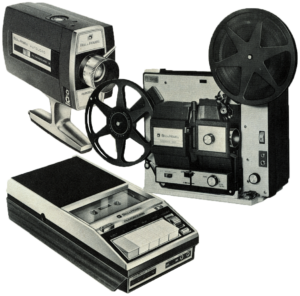
What Is It?
With the introduction of Super8 home movie film in the mid-1960s came an option for sound. But it was pricy and not widely sold. But there was more than one 8mm Super8 sound format offered to the consumer. The most common format was one that used film manufactured with magnetic sound striping. The movie film camera had its own magnetic sound recorder. As the film was exposed, with it was recorded a sound track directly on the film’s magnetic sound stripe. This was a relatively simple configuration except that there was a microphone and lengthy cable that had to be carefully managed so as to avoid persons tripping over it. The only thing to complicate matters relative to Super8 silent home movies was the microphone and its cable.
But there was another format that was even more rare. No doubt, it was rare because the configuration for its use was extremely complicated relative to silent and even relative to the Super8 sound described above. Its redeeming value was that it delivered an improved quality of home movies. To understand this configuration, consider the figure shown at the top of this page. While the earlier described configuration included an audio recording mechanism within the home movie camera, this configuration used a specially designed audio cassette recorder that the user wired into the system. For recording there was a specially designed audio cassette recorder wired to the camera and a microphone wired to the recorder. For playback there was a movie camera wired to an audio cassette recorder which was w2ired to a specially designed Super8 movie projector. What made this configuration complicated and susceptible to error was the extreme synchronization that had to be maintained within the entire system. But, as noted, earlier, the quality was improved. True lip-sync was easily achieved.
Married for Life
This configuration necessitated a standalone audio cassette permanently married to a 50 foot reel of Super8 home movie film. The two must remain together forever and never be separated through loss. Once a link between the two is lost, all that is possible is to listen to the audio recording and, as a separate event, project the movie film.
Duplicating to Digital
Capturing quality home movies with sound and then projecting them, displaying the full quality possible, was one thing back in 1970. But in the 21st century, duplicating these to digital is something else. We start with a “married” pair audio cassette and matching 50 foot Super8 movie film reel. The movie film reel is duplicated to mp4 digital as a standalone reel. Likewise, the matching audio cassette is duplicated to mp3 digital as a standalone process. Those two processes are routine and mundane and priced as such. For duplication to digital purposes, they are viewed as two separate and unrelated events. There is a fee for an audio cassette duplication to mp3 and another fee for an 8mm silent film reel duplication to mp4.
Now the Hard Part
But there is a third process that follows that is labor-intense. The movie film is viewed together with the audio cassette. We look for two synchronization points where there is a scene change matched by an audio change. The first synchronization point must be near the beginning of the reel and the second is optimally found near the end. With two synchronization points identified, the film speed is adjusted such that these two points occur properly placed. The labor is equivalent to the duplication of two 8mm silent films.
Pricing Summarized
Let $X/ft represent the cost per foot of duplicating to mp4 8mm silent film. There are three such operations for each FilmOSound reel and thus the fee would include 3 * $X/ft. Supplement that with the cost to duplicate an audio cassette to mp3 and you have the complete cost list Michigan sales tax.
